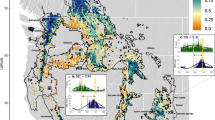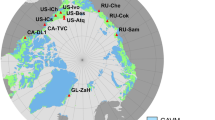Abstract
Refugia are habitats that allow organisms to persist when the environment makes persistence impossible elsewhere. The subnivium—the interface between snowpack and ground—is an important seasonal refugium that protects diverse species from extreme winter temperatures, but its future duration is uncertain with climate change. Here, we predict that subnivium duration will decrease from 126 d (2010–2014) to 110 d (2071–2100), which we have inferred using past and future duration of frozen ground with snow cover (Dsc) derived from remotely sensed datasets and climate projections. Concomitantly, duration of frozen ground without snow cover (Dfwos) at mid-latitudes is predicted to increase from 35 d to 45 d, with notable increases in the western United States, Europe, the Tibetan Plateau and Mongolia. In most areas, increasing winter temperatures were more important than precipitation for decreasing Dsc and increasing Dfwos. Thus, counter-intuitively, warming climate will cause longer Dfwos at mid-latitudes, causing functional winter cooling for subnivium-dependent organisms.
This is a preview of subscription content, access via your institution
Access options
Access Nature and 54 other Nature Portfolio journals
Get Nature+, our best-value online-access subscription
$29.99 / 30 days
cancel any time
Subscribe to this journal
Receive 12 print issues and online access
$209.00 per year
only $17.42 per issue
Buy this article
- Purchase on Springer Link
- Instant access to full article PDF
Prices may be subject to local taxes which are calculated during checkout






Similar content being viewed by others
Data availability
All data used can be freely downloaded from Zenodo (https://doi.org/10.5281/zenodo.3376316) and are also available from the corresponding authors upon request.
Code availability
The Python and R code used for calculations and analyses can be accessed at GitHub (https://github.com/likai-hub/climate-change-and-subnivium-duration) and is also available from the corresponding authors upon request.
References
Zhang, T. Influence of the seasonal snow cover on the ground thermal regime: an overview. Rev. Geophys. 43, RG4002 (2005).
Pauli, J. N., Zuckerberg, B., Whiteman, J. P. & Porter, W. The subnivium: a deteriorating seasonal refugium. Front. Ecol. Environ. 11, 260–267 (2013).
Curtis, J. T. The Vegetation of Wisconsin: An Ordination of Plant Communities (Univ. Wisconsin Press, 1959).
Brown, P. J. & DeGaetano, A. T. A paradox of cooling winter soil surface temperatures in a warming northeastern United States. Agric. Meteorol. 151, 947–956 (2011).
Groffman, P. M. et al. Colder soils in a warmer world: a snow manipulation study in a northern hardwood forest ecosystem. Biogeochemistry 56, 135–150 (2001).
Comerford, D. P. et al. Influence of experimental snow removal on root and canopy physiology of sugar maple trees in a northern hardwood forest. Oecologia 171, 261–269 (2013).
Penczykowski, R. M., Connolly, B. M. & Barton, B. T. Winter is changing: trophic interactions under altered snow regimes. Food Webs 13, 80–91 (2017).
Williams, C. M., Henry, H. A. L. & Sinclair, B. J. Cold truths: how winter drives responses of terrestrial organisms to climate change. Biol. Rev. 90, 214–235 (2015).
Petty, S. K., Zuckerberg, B. & Pauli, J. N. Winter conditions and land cover structure the subnivium, a seasonal refuge beneath the snow. PLoS ONE 10, e0127613 (2015).
Peng, S. et al. Change in snow phenology and its potential feedback to temperature in the Northern Hemisphere over the last three decades. Environ. Res. Lett. 8, 014008 (2013).
Choi, G., Robinson, D. A. & Kang, S. Changing Northern Hemisphere snow seasons. J. Clim. 23, 5305–5310 (2010).
Brown, R. D. & Robinson, D. A. Northern Hemisphere spring snow cover variability and change over 1922–2010 including an assessment of uncertainty. Cryosphere 5, 219–229 (2011).
Hori, M. et al. A 38-year (1978–2015) Northern Hemisphere daily snow cover extent product derived using consistent objective criteria from satellite-borne optical sensors. Remote Sens. Environ. 191, 402–418 (2017).
Kim, Y., Kimball, J. S., Zhang, K. & McDonald, K. C. Satellite detection of increasing Northern Hemisphere non-frozen seasons from 1979 to 2008: implications for regional vegetation growth. Remote Sens. Environ. 121, 472–487 (2012).
Zhang, K., Kimball, J. S., Kim, Y. & Mcdonald, K. C. Changing freeze-thaw seasons in northern high latitudes and associated influences on evapotranspiration. Hydrol. Process. 25, 4142–4151 (2011).
Blume-Werry, G., Kreyling, J., Laudon, H. & Milbau, A. Short-term climate change manipulation effects do not scale up to long-term legacies: effects of an absent snow cover on boreal forest plants. J. Ecol. 104, 1638–1648 (2016).
Carlson, B. Z., Choler, P., Renaud, J., Dedieu, J. P. & Thuiller, W. Modelling snow cover duration improves predictions of functional and taxonomic diversity for alpine plant communities. Ann. Bot. 116, 1023–1034 (2015).
Bale, J. S. & Hayward, S. A. L. Insect overwintering in a changing climate. J. Exp. Biol. 213, 980–994 (2010).
Roland, J. & Matter, S. F. Pivotal effect of early-winter temperatures and snowfall on population growth of alpine Parnassius smintheus butterflies. Ecol. Monogr. 86, 412–428 (2016).
Kausrud, K. L. et al. Linking climate change to lemming cycles. Nature 456, 93–97 (2008).
Pedersen, S., Odden, M. & Pedersen, H. C. Climate change induced molting mismatch? Mountain hare abundance reduced by duration of snow cover and predator abundance. Ecosphere 8, 1–8 (2017).
Sultaire, S. M. et al. Climate change surpasses land-use change in the contracting range boundary of a winter-adapted mammal. Proc. R. Soc. B 283, 20153104 (2016).
Brown, R. D. & Mote, P. W. The response of Northern Hemisphere snow cover to a changing climate. J. Clim. 22, 2124–2145 (2009).
Zhu, L., Radeloff, V. C. & Ives, A. R. Characterizing global patterns of frozen ground with and without snow cover using microwave and MODIS satellite data products. Remote Sens. Environ. 191, 168–178 (2017).
Hall, D. K., Riggs, G. A., Salomonson, V. V., Digirolamo, N. E. & Bayr, K. J. MODIS snow-cover products. Remote Sens. Environ. 83, 181–194 (2002).
Kim, Y., Kimball, J. S., McDonald, K. C. & Glassy, J. Developing a global data record of daily landscape freeze/thaw status using satellite passive microwave remote sensing. IEEE Trans. Geosci. Remote Sens. 49, 949–960 (2011).
Thompson, K. L., Zuckerberg, B., Porter, W. P. & Pauli, J. N. The phenology of the subnivium. Environ. Res. Lett. 13, 064037 (2018).
Ge, Y. & Gong, G. Land surface insulation response to snow depth variability. J. Geophys. Res. 115, D08107 (2010).
Sturm, M., Holmgren, J., König, M. & Morris, K. The thermal conductivity of seasonal snow. J. Glaciol. 43, 26–41 (2017).
Harris, I., Jones, P. D., Osborn, T. J. & Lister, D. H. Updated high-resolution grids of monthly climatic observations—The CRU TS3.10 Dataset. Int. J. Climatol. 34, 623–642 (2014).
Maurer, E. P., Brekke, L., Pruitt, T. & Duffy, P. B. Fine-resolution climate projections enhance regional climate change impact studies. Eos Trans. Am. Geophys. Union 88, 504–504 (2007).
Seager, R. & Vecchi, G. A. Greenhouse warming and the 21st century hydroclimate of southwestern North America. Proc. Natl Acad. Sci. USA 107, 21277–21282 (2010).
McCabe, G. J. & Wolock, D. M. Long-term variability in Northern Hemisphere snow cover and associations with warmer winters. Climatic Change 99, 141–153 (2010).
Korslund, L. & Steen, H. Small rodent winter survival: snow conditions limit access to food resources. J. Anim. Ecol. 75, 156–166 (2006).
Connolly, B. M. & Orrock, J. L. Climatic variation and seed persistence: freeze–thaw cycles lower survival via the joint action of abiotic stress and fungal pathogens. Oecologia 179, 609–616 (2015).
Kreyling, J. Winter climate change: a critical factor for temperate vegetation performance. Ecology 91, 1939–1948 (2010).
Fountain, A. G. et al. The disappearing cryosphere: impacts and ecosystem responses to rapid cryosphere loss. Bioscience 62, 405–415 (2012).
Hawkins, B. A., Rueda, M., Rangel, T. F. & Field, R. Community phylogenetics at the biogeographical scale: cold tolerance, niche conservatism and the structure of North American forests. J. Biogeogr. 41, 23–38 (2014).
Zuckerberg, B. & Pauli, J. N. Conserving and managing the subnivium. Conserv. Biol. 32, 774–781 (2018).
Kim, Y., Kimball, J. S., Glassy, J. & Du, J. An extended global Earth system data record on daily landscape freeze–thaw status determined from satellite passive microwave remote sensing. Earth Syst. Sci. Data 9, 133–147 (2017).
Kim, Y., Kimball, J. S., Robinson, D. A. & Derksen, C. New satellite climate data records indicate strong coupling between recent frozen season changes and snow cover over high northern latitudes. Environ. Res. Lett. 10, 084004 (2015).
Frei, A. et al. A review of global satellite-derived snow products. Adv. Space Res. 50, 1007–1029 (2012).
Gao, Y., Xie, H., Yao, T. & Xue, C. Integrated assessment on multi-temporal and multi-sensor combinations for reducing cloud obscuration of MODIS snow cover products of the Pacific Northwest USA. Remote Sens. Environ. 114, 1662–1675 (2010).
Acknowledgements
Support for this work was provided by NSF/NASA’s Dimensions of Biodiversity programme (1240804), NASA’s Biodiversity and Ecological Forecasting programme (grant no. NNX14AP07G), Shandong Provincial Natural Science Foundation, China (grant no. ZR2019BD040), the open fund of the Ministry of Education Laboratory for Earth Surface Processes, Peking University, and the National Natural Science Foundation of China (grant no. 41701220). C.Z. is supported by the Taishan Scholars Program of Shandong, China (grant no. ts201712071). We thank the US Department of the Interior’s Bureau of Reclamation for providing the ‘Downscaled CMIP3 and CMIP5 Climate and Hydrology Projections’ archive.
Author information
Authors and Affiliations
Contributions
L.Z., A.R.I. and V.C.R. designed the study. L.Z., A.R.I., C.Z., Y.G. and V.C.R. analysed data. L.Z., A.R.I., C.Z., Y.G. and V.C.R. wrote the paper.
Corresponding authors
Ethics declarations
Competing interests
The authors declare no competing interests.
Additional information
Publisher’s note Springer Nature remains neutral with regard to jurisdictional claims in published maps and institutional affiliations.
Supplementary information
Supplementary Information
Supplementary Figs. 1–17 and Tables 1–4.
Rights and permissions
About this article
Cite this article
Zhu, L., Ives, A.R., Zhang, C. et al. Climate change causes functionally colder winters for snow cover-dependent organisms. Nat. Clim. Chang. 9, 886–893 (2019). https://doi.org/10.1038/s41558-019-0588-4
Received:
Accepted:
Published:
Issue Date:
DOI: https://doi.org/10.1038/s41558-019-0588-4
This article is cited by
-
Bioclimatic atlas of the terrestrial Arctic
Scientific Data (2023)
-
Impact of tourism development upon environmental sustainability: a suggested framework for sustainable ecotourism
Environmental Science and Pollution Research (2023)
-
The critical benefits of snowpack insulation and snowmelt for winter wheat productivity
Nature Climate Change (2022)
-
Winter in a warming Arctic
Nature Climate Change (2020)
-
Fine-scale tundra vegetation patterns are strongly related to winter thermal conditions
Nature Climate Change (2020)



